What temperature to turn on the air conditioner: parameters and standards for different times
In summer, indoor temperatures often rise above comfortable levels.This is not only inconvenient, but can seriously affect your health.
Agree, open windows and a fan, even in not the most extreme heat, are unable to maintain a comfortable temperature in the room. The optimal solution to the temperature problem is to install an air conditioner. But what temperature can be considered comfortable and is it dangerous for your health to constantly be in a room with the air conditioner on?
In this article we will look in detail at what temperature to turn on the air conditioner so that the heat does not bother you, what you need to do to avoid getting sick, and how to properly use the climate control split system not only for cooling the room, but also for heating in case of emergency .
The content of the article:
- How to set the temperature correctly in summer?
- Why is it important to observe the temperature difference?
- Efficient and economical use
- Ventilation of the room with air conditioning
- How to avoid colds?
- Comfortable stay in an air-conditioned room
- What temperature should I set for sleeping?
- Using an air conditioner for heating
- Conclusions and useful video on the topic
How to set the temperature correctly in summer?
Comfort is a very relative concept. Some people may feel fine even at 30 degrees, but for others it may seem like real hell. There are no standards for the operating temperature of an air conditioner in the legislation, but there are requirements SanPiN 2.1.2.2645-10regulating the temperature in residential buildings during the warm season.
It is from this document that it is worth starting first of all, SanPiN 2.1.2.2645-10 states that optimal room temperature it will be 22-25 degrees.It is also worth paying attention to the instructions for the air conditioner; it will indicate what temperature is optimal to set.
If it is 30 degrees outside, then the optimal temperature of the air conditioner will be approximately 25. SanPiN 2.1.2.2645-10 allows deviations of up to 20-28 degrees. But at this temperature the absolute majority will be uncomfortable and it is better not to expose it to air conditioning.
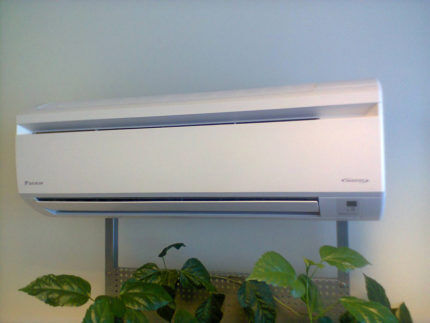
It is recommended to set the desired temperature in several stages.
For a heat of 30 degrees it will look like this:
- turn on the air conditioner and let it cool the room to 28 degrees;
- after 10-15 minutes you can reduce the temperature to 25 degrees;
- after 30-40 minutes the temperature can be lowered to 23 degrees.
It is not recommended to cool the air below 23 degrees, as in this case a person’s blood vessels begin to narrow.
This is a natural protection against hypothermia, but it causes discomfort in the form of drying out the mucous membranes of the nose, throat and eyes.
Why is it important to observe the temperature difference?
Modern climate control equipment works wonders. Outside the window it may be incredibly hot at 40 degrees, but indoors the air conditioner can maintain a comfortable coolness of 20 degrees.
But it is worth considering that sudden temperature changes of more than 7 degrees can cause ARVI with further exacerbations, even pneumonia. If you walk from a hot street into a cool room with air conditioning, you will feel comfortable. However, the risk of getting sick will increase several times.
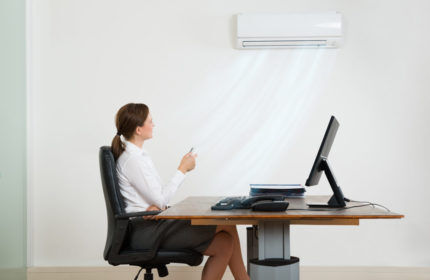
Therefore, it is necessary to set the temperature of the air conditioner in rooms where people often enter and exit, taking into account the above difference.
If we are talking about office space, then failure to comply with this simple rule can lead to all employees going on sick leave.
Efficient and economical use
We figured out what optimal temperature an air conditioner should maintain in the summer. Setting up an air conditioner and enjoying comfort is quite simple, however, it can cost a pretty penny. Climate control equipment consumes a large amount of electricity.
And if you don’t want your electricity bill to increase several times, then you should follow a few simple rules:
- Curtain the curtains. This will protect the room from heating by the sun, which means less energy will be needed to cool the room.
- Set the air flow to the minimum speed. Yes, in this case the room will cool down a little slower, but 15-20 minutes will definitely not be critical.
Be sure to close windows and doors indoors. - Adjust the angle of the horizontal blinds parallel to the floor. In this case, the cooled air will fall down and the hot air will rise to the top. This will allow you to quickly bring the room to the desired temperature.
If your model does not have the ability to adjust the blinds, then install a protective screen directly under the air conditioner.
In this case, the air flow will dissipate immediately, which will increase the efficiency of the air conditioner.
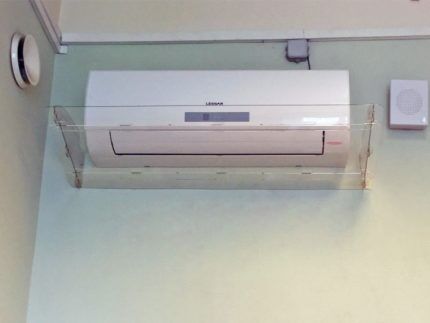
The cost of protective screens is small - from 1000 rubles. But you can make it yourself from plexiglass or plexiglass.
Ventilation of the room with air conditioning
There is one more important thing to consider. The air conditioner does not interact with the air outside in any way. It circulates the same air around the room, and the external installation is only responsible for removing excess heat from the room.
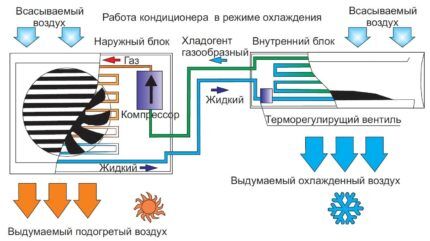
Air exchange is also important to maintain comfortable indoor conditions. And if you do not ventilate the room for a long time, the oxygen level will decrease and the level of carbon dioxide will increase. Of course, this is not fatal, but the lack of oxygen can make you feel tired and drowsy.
Before ventilating the room, be sure to turn off the air conditioner. Open windows and, if possible, doors. This creates a draft, but allows the air to renew itself very quickly. It is advisable that at this moment there is no one in the room, especially children. If there is no way to free up the room, then it is better to limit yourself to windows only.
We said above that when the air conditioner is on, it is necessary to close the windows, and when ventilating, turn off the air conditioner. Let's figure out why this needs to be done.
Modern air conditioners do not blow at the set power all the time. They cool the room to a set temperature, after which they begin to work to maintain it. This allows you to wear out the equipment and filters less quickly and save energy.
If you open the windows when the air conditioner is on, active air exchange will begin to occur in the room. Hot air from the street will replace the cooled air in the room. In this case, the air conditioner will work at full capacity, actually cooling the street.
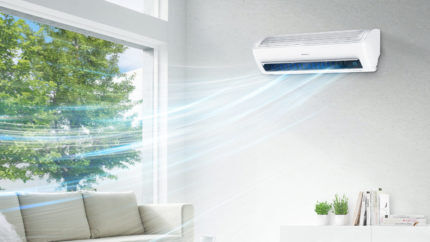
If you forget about it once, then nothing bad will happen. However, repeating this on a regular basis, there is a high chance of being left without air conditioning and with a huge electricity bill.
We also recommend reading our other article, where we described in detail operating principle of air conditioner.
How to avoid colds?
You can often hear that air conditioning, especially in summer, is the cause of colds. This mainly happens due to failure to maintain the temperature difference indoors and outdoors. But besides this, there are two more factors that can cause colds.
The first is air flows; even short-term exposure to a powerful cold air flow can lead to a cold. The easiest and most obvious way to avoid this is to not be underneath it. If this cannot be avoided, for example, your workplace is located there, then it is worth installing a protective screen.
The second reason is less obvious - pathogenic bacteria. The air conditioner continuously circulates the same air in the room. And to ensure that dust and other small particles do not get clogged into important parts, filters are installed.
It is recommended to clean them at least once a year. In addition to taking care of your health, this will significantly extend the life of the air conditioner.
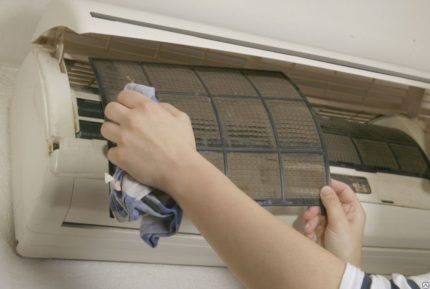
If you do not clean them and change them in time, the filters become a breeding ground for germs and bacteria.
Comfortable stay in an air-conditioned room
Temperature is the most important factor, but not the only one, that is affected by the air conditioner turned on in the room.
In addition to maintaining the temperature at a set value, the air conditioner dehumidifies the air. This can cause the mucous membranes of the nose and throat to dry out. For some people, this causes discomfort in the form of a runny nose and sore throat.

This can be avoided if you install it in the room humidifier. It is also recommended to drink more water, this will protect your mucous membranes from drying out.
What temperature should I set for sleeping?
Properly setting the air conditioner temperature can provide you with a comfortable sleep. Many modern models have a “sleep mode”; just turn it on and you can go to bed. The required temperature will be set automatically.
If it is not there, then the settings must be set manually:
- Raise the temperature 1-2 degrees above daytime. At night, the human body cools down and additional heating is required.
- Adjust the blinds so that air flows do not flow onto the bed.
- Set the shaft rotation speed to minimum. In addition to maintaining the temperature regime, this will make the air conditioner quieter, which also contributes to a comfortable sleep.
Based on general recommendations, it turns out that the optimal temperature for sleeping will be 25-27 degrees.
“Sleep mode” works according to the following principle. First, it resets the fan speed to minimum. Secondly, it directs the blinds so that the air flows parallel to the floor. Thirdly, it increases the temperature to the desired level.
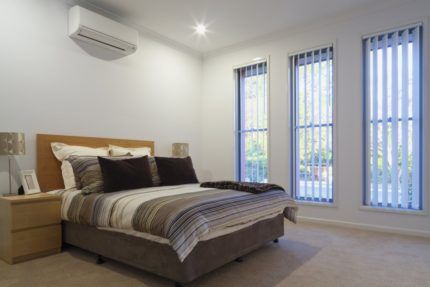
The only problem that may arise during sleep is ventilation. Having set the optimal air conditioner temperature for the night, do not forget that the windows must be closed, otherwise the equipment will wear out.
If the flow of clean air is very important, then you can leave a small gap in the window, but this is the permissible maximum.
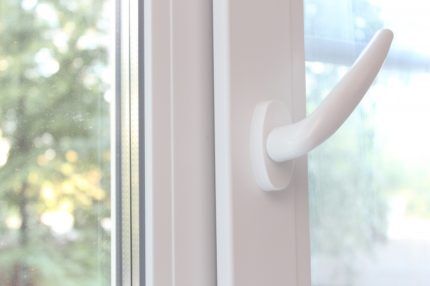
Another option to solve this problem is to ventilate the room immediately before going to bed. During sleep, a person consumes significantly less oxygen and this should be enough for the whole night.
Using an air conditioner for heating
Many modern models can not only cool the air, but also operate in heating mode. However, there are a lot of nuances that should be taken into account.
The most important of them is the temperature range. The lower bar for most models is at a level from -5 to +5 degrees.
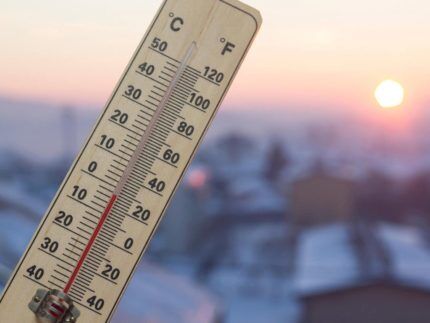
If we talk about inverter air conditioners, then their lower limit is at -15 degrees. At the same time, they have a high EER coefficient of up to 4. It shows operating efficiency. For every kilowatt of energy expended, such air conditioners will produce 4 kilowatts of heat.
If you turn on the air conditioner for heating at a temperature below the permissible temperature, then you should prepare for unpleasant consequences. The oil in the refrigerant will thicken, causing the compressor to wear out. If you actively use the air conditioner for heating during the cold season, it may fail in the first season, and no warranty service will help you.
Another important point regarding temperature conditions. Despite the stated operating temperature, you should not turn on the air conditioner for heating at subzero temperatures outside.
In this case, condensate will begin to freeze on the heat exchanger located outside. This is not fatal for climate control equipment, but under such conditions the performance of the air conditioner is significantly reduced, which leads to additional wear and tear on the equipment and energy costs.
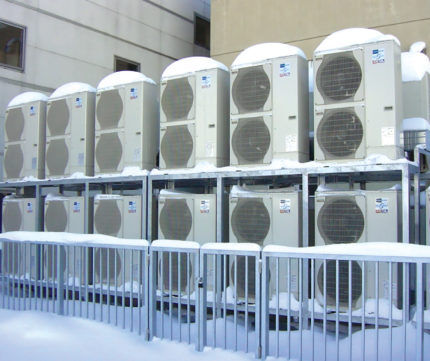
The optimal temperature at which you can turn on the air conditioner for heating considered +5 degrees. In this case, you will keep warm and there will be no wear and tear on the equipment.
However, we recommend using this function exclusively in the off-season in isolated cases. If during the cold season you have problems heating the room, then use special heating equipment.
Preparing climate control equipment for winter
Manufacturers of household air conditioners recommend preserving equipment during the cold season. But if you still decide that you will use your air conditioner for heating in winter, then it must be prepare for this.
The first thing to do is to clean the heat exchanger of the indoor unit from any remaining moisture. To do this, just turn on the air conditioner for a few hours - the moisture will evaporate on its own. Waterproof the outdoor unit.
To do this, just cover it with some waterproof material. Clean your air conditioner filters; you can do this yourself. If you are concerned about the safety of your equipment, then it is better to entrust the preparation for winter to a specialist.
What are winter kits for?
Manufacturers often offer to buy special winter kits for the air conditioner. Some models of climate control equipment are equipped with them by default. The winter kit does not allow the use of air conditioning for heating; it expands the temperature range for cooling the premises.
That is, if your air conditioner has a minimum temperature of -5 degrees, the winter kit will reduce it to -15-20 degrees when working to cool the room. But this does not mean that it will be possible to turn on the air conditioner for heating at such low temperatures.
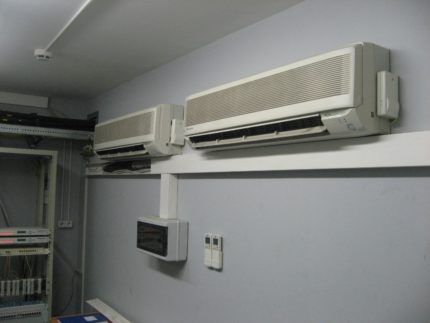
It consists of several elements:
- Engine speed regulator. Controls the temperature of the refrigerant condensate in the outdoor unit. If necessary, it slows down the air conditioner motor, preventing low-temperature refrigerant from entering the indoor unit.
- Drain tube heater. Ensures uninterrupted operation of the water drainage system.
- Compressor crankcase heater. Responsible for heating the thickened oil before starting the air conditioner.
There is no universal solution; the manufacturer creates its own winter kits for each model. Some air conditioners, in principle, do not have the ability to install the above elements.
Therefore, before purchasing, be sure to consult with a specialist if expanding the temperature range is necessary.
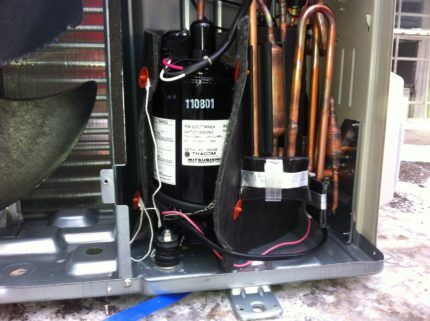
If the power of the compressor crankcase heater is low, you will have to wait a long time before starting the air conditioner. The waiting time can last up to 30-40 minutes.
Starting air conditioning equipment without sufficiently warming up the compressor can lead to rapid breakdown. The need to monitor this is the main disadvantage when working with a winter kit.
Conclusions and useful video on the topic
How to use conditioner correctly:
A properly configured air conditioner will create comfortable temperature conditions in the room. At the same time, you won’t have to worry about someone catching a cold.
However, more complex manipulations with climate control equipment, for example, installation of a winter kit, should be entrusted to specialists.In this case, you will be sure that everything is done correctly, and your air conditioner will not fail ahead of time.
If you have questions or can supplement our material with interesting information on the topic of the article, please leave your comments and ask questions - the contact block is located under the article.



